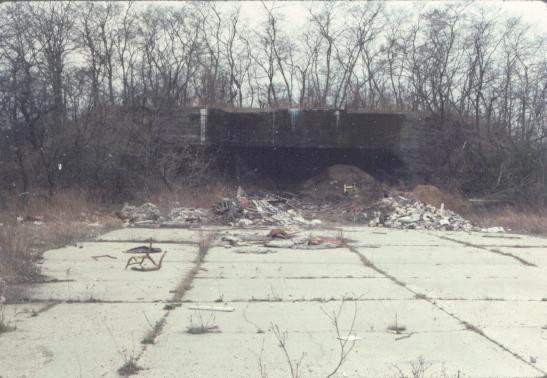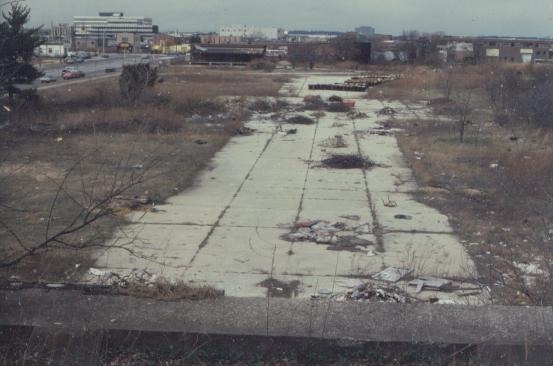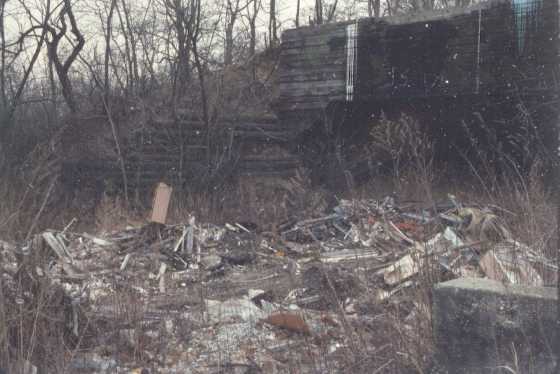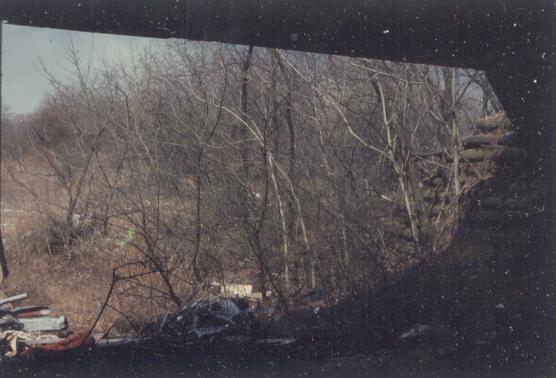
Copyright © 2001-2006 Arthur John Huneke
ALL RIGHTS RESERVED
MITCHEL FIELD
??? BUNKER ???

LOOKING NORTH - OAK STREET AT LEFT, COMMERCIAL AVENUE IN DISTANCE



ED HANRAHAN OFFERS AN EXPLANATION OR TWO.
| "My family moved from Brooklyn to Stewart Manor, just north of the Hempstead
Branch, when I was 5, in '52. As a student, (St. Anne's School in Garden City)
we did tour the active Mitchell Field several times. As a teenager with a
driver's license in the mid-to-late 60's, I spent a fair amount of time
exploring the abandoned Mitchell Field. That's why your caption of
"???Bunker???" got my attention.
"I suspected at the time that the (then) fairly remote site was set up for the stress-testing of jet engines, allowing for the possibility of an explosion. The large cavernous area within the (I believe) man-made hill had several metal-lined stacks in the top of it, ventilating the interior up to ground (hill-top) level. The 2 to 4 (maybe more?) stacks were 2 or 3 feet in diameter and ended right at ground level. There were recessed tie-down points in the large concrete pad in front of the opening, similar to those on the deck of aircraft carriers (my dad was an engineer at the Brooklyn Navy Yard, and we made liberal use of family days). The concrete taxiway leading to the area had a slight but definite downhill slope to it, contributing to both security in case of explosion and the likelihood that the hill was man-made. "Thinking back now, a more likely use of the "bunker" would be to "sight in" the aiming of fighter planes' machine guns upon installation, firing them into the well-protected cavern. That's a necessary and not entirely straightforward process (various crossing patterns were used - may still be!) that would be difficult to test out on a totally flat field that, even in the 50's, was pretty well surrounded by civilization. "Feel free to add any or all of this to the web page (even the part below!)." - Ed Hanrahan West Caldwell, NJ "P.S.: And, uhmmm, that well-shielded "bunker" area DID see some use in the wee hours of the morning, but that's another story! Also high-speed driving on the abandoned runways & taxiways. '68 Mustang should have rolled one night when I spun off the edge - stayed upright although breathing lots of dust!" |
ANTHONY TOO OFFERS AN EXPLANATION.
|
Hello Love your page on Mitchell Field ,that "bunker" was used as a firing/testing range for personal and fighters . As kids we would dig for spent ammo inside which was filled with sand and come up with what I now know to be spent 50 cal on down to 22 cal. I think the vents were to keep the dust and smoke down as well as \to baffle some of the sound up. There was what we called a bunker just off the end of the main runway ,a rectangular building with a massive steel doors with locks none of us had ever seen before. One day ,, about 1969 or 70 there were piles of old Army Air Force files and photos dumped outside this building ,I assume that they used this building to store old base records when it closed and they were cleaning house. If I only knew then what I know now , all that history lost forever ,I would have taken home a lot more but I was a kid and all I took were a few dozen huge photos of the base, planes and bombing runs and over the next few weeks the rain made a mess of what was left, then it was bulldozed under along with items from the other buildings. We played on that base and in the old building and hangers for many years but were never destructive. We even made it up the old control tower next to the last hanger. When I later joined the Air Force I tried from time to time to find out where the history files of the base were shipped but I have a feeling that was what was in that pile. If you have any questions ,I might know the answer and would be happy to help if I can. Regards, Anthony |
RETURN TO TOP